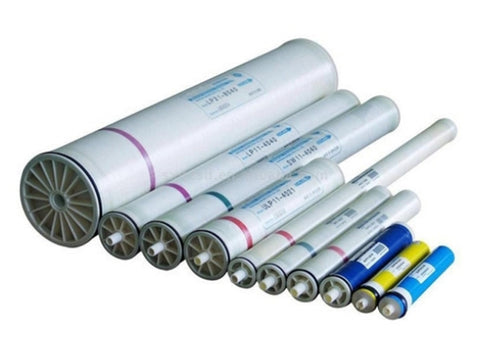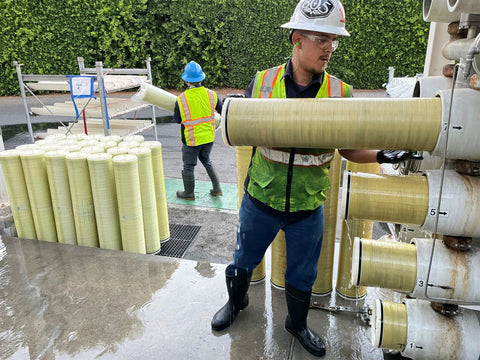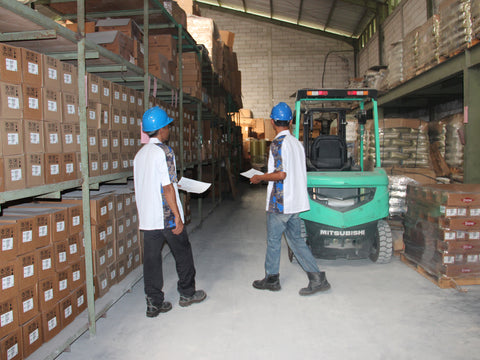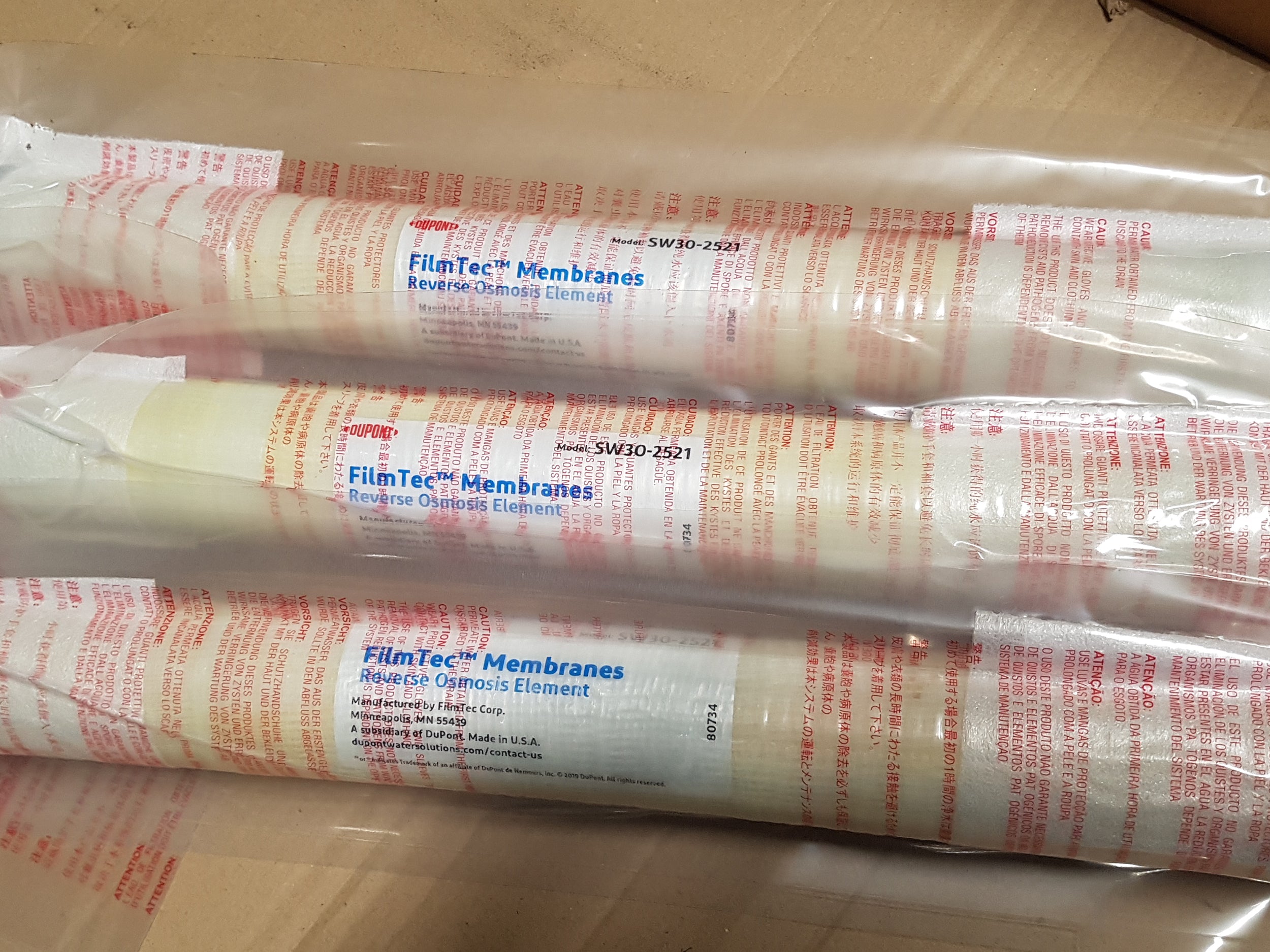Causes of Damage to Reverse Osmosis Membranes
In the world of water filtration, reverse osmosis (RO) technology is one of the most effective methods to produce clean water that meets health standards. However, there is a common problem that is often encountered, which is a broken reverse osmosis membrane.
The causes of a ruptured reverse osmosis membrane can be diverse, ranging from particle accumulation, too high pressure, to the use of inappropriate chemicals. Understanding these causes is an important first step to avoiding damage and ensuring the water filtration system operates optimally.

Understanding of Reverse Osmosis Membrane
The reverse osmosis membrane, the core of an RO filtration system, functions to separate contaminants from water by forcing water through a semi-permeable membrane at high pressure. Its uniqueness lies in its ability to filter out particles, minerals, bacteria, and viruses, resulting in cleaner, healthier water. These membranes, which are made of fine synthetic materials, have high selectivity in filtering out unwanted solutes and microorganisms, providing an effective solution for highly contaminated water sources.
This technology offers efficiencies in water filtration and water treatment.
This technology offers exceptional filtration efficiency, capable of eliminating harmful contaminants while retaining water molecules, making it ideal for a wide range of applications, from drinking water supply to industries that require very strict water hygiene standards. With application flexibility at various scales, reverse osmosis is becoming a popular and effective water filtration method globally.

Common and Specific Causes of Damage to RO Membranes
Ensuring the integrity of reverse osmosis (RO) membranes is key to the efficient operation of RO water filtration systems. Damage to these membranes can result in a significant reduction in the quality and quantity of water produced, making it an important issue that must be addressed with a deep understanding of the various factors that can affect membrane performance and durability.
The following are common and specific causes of damage to RO membranes that need to be known in order to optimize the operation of RO water filtration systems.
- .
-
Common Causes of RO Membrane Damage
-
Particle Accumulation: Apart from sand, rust, or sediment, particle accumulation can also come from organic deposits or biofilms formed due to the presence of microorganisms. This not only obstructs the flow of water but can also be a medium for the growth of bacteria that can potentially damage the membrane. Pre-treatments such as filtration and the use of ultraviolet can reduce the risk of this accumulation.
-
Overpressure: The cause of excess pressure can come from a faulty pump setting, damage to the pressure regulating valve, or unpredictable fluctuations in water source pressure. To prevent damage due to excessively high pressure, automatic control systems and manual pressure supervisors should be implemented to ensure operation within safe limits.
-
Inappropriate Chemicals: The use of inappropriate chemicals can not only damage the membrane but can also disrupt the pH balance of the treated water, further affecting the membrane's ability to filter contaminants. In addition, certain chemicals can react with the membrane material, causing irreparable structural damage. Selection of appropriate chemicals, based on the manufacturer's recommendations and compatibility tests, is important to maintain the quality and service life of the membrane.
-
-
Specific Causes of Damage to RO Membranes
-
Microbiological Fouling: Apart from microbial growth, microbiological fouling can also be caused by metabolic by-products of microorganisms, such as exopolymers. These exopolymers are very sticky and can cover the membrane surface, complicating the cleaning process. The use of pre-treatment techniques such as micro filtration and biocide dosing can help reduce the risk of microbiological fouling.
-
Scaling Minerals: In addition to calcium, magnesium, and silica, scaling can also result from the precipitation of barium, strontium, and iron. This precipitation not only reduces the flow rate of water through the membrane but can also cause permanent damage. Pre-treatment techniques such as the addition of anti-scalant agents and water softener systems can effectively prevent scaling from occurring.
-
Damage by Chlorine: Long-term exposure to chlorine not only damages the membrane material but can also reduce the membrane's ability to block contaminants, causing a decrease in the quality of water produced. The use of an activated carbon filter prior to the RO process can remove chlorine from the raw water and protect the membrane from damage.
-
Temperature Influence: Extreme temperature variations can accelerate membrane aging and change the physical properties of membrane materials, ultimately affecting the selectivity and permeability of the membrane. Implementation of temperature controls on the inlet water and surrounding environment of the RO system can help minimize the negative impact of temperature fluctuations.
-
Inappropriate Operation and Maintenance: Over-flushing and under-flushing can both be detrimental. Over-flushing can cause membrane erosion, while under-flushing causes contaminant accumulation. Operator training and consistent schedule-based maintenance are important to ensure proper RO system operation and maintenance.

Damage to reverse osmosis membranes not only results in a decrease in the quality of water produced but also has the potential to significantly reduce the operational efficiency of the water filtration system. An in-depth understanding of the various causes of damage to membranes-from particle accumulation, to inappropriate pressurization, to improper chemical usage-is an important step in damage prevention. By implementing effective preventive measures, such as regular maintenance, proper pressure regulation, and appropriate chemical selection, we can improve the performance and extend the lifespan of RO water filtration systems.
Furthermore, it is important to realize that proper maintenance and operation play a crucial role in maintaining the integrity of RO membranes. This includes monitoring operational pressure, using water pre-treatment to reduce contaminants before entering the RO system, and cleaning and replacing membranes according to the recommended schedule. As such, the implementation of a comprehensive and ongoing maintenance strategy is a worthwhile investment to ensure the efficiency of a reverse osmosis water filtration system.
Watermart, as a distributor of water filtration equipment in Indonesia, understands the importance of reverse osmosis technology in providing clean and healthy water. We are committed to providing high quality solutions and products that meet your water filtration needs. With reliable technical support and proven products, Watermart is ready to be a reliable partner in ensuring your access to safe, clean water that meets health standards through effective and efficient reverse osmosis technology.
We believe that with good cooperation and a deep understanding of water filtration systems, we can overcome water filtration challenges and ensure the availability of clean water for all.
-

.png?width=50&height=50&name=Logo_Watermart_Perkasa-removebg-preview%20(1).png)


